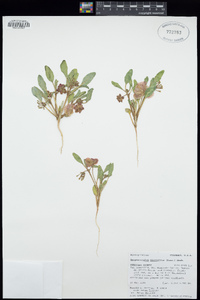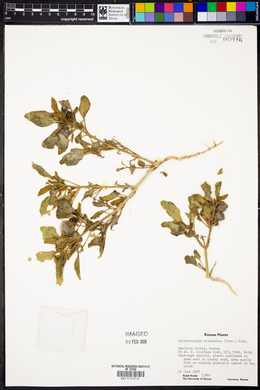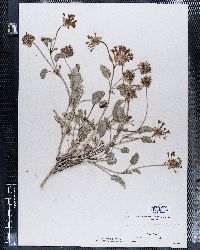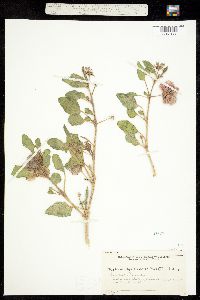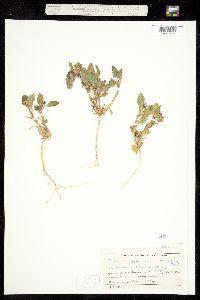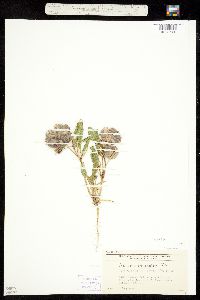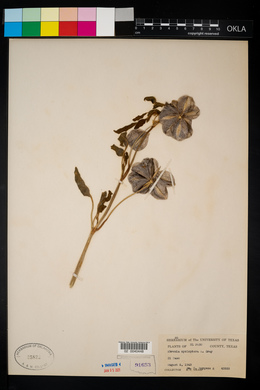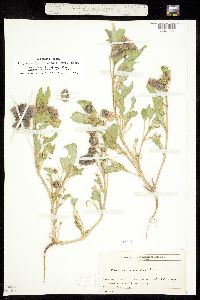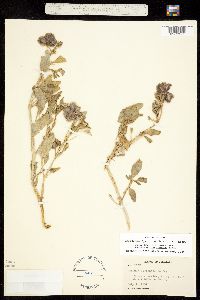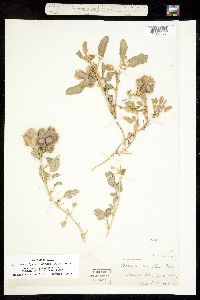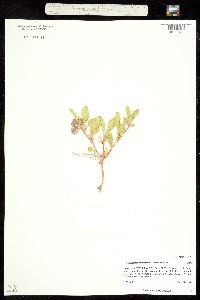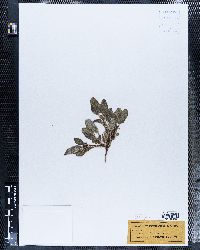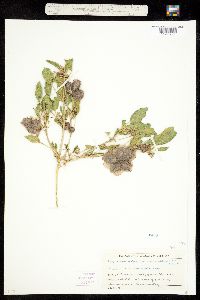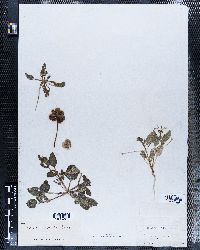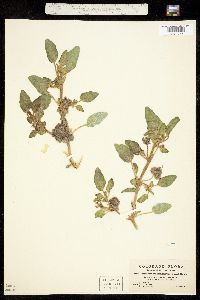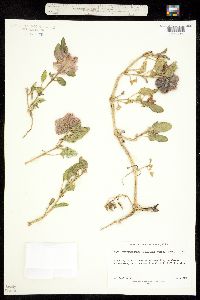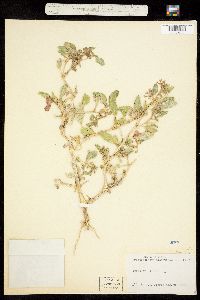Tripterocalyx micranthus
|
|
|
|
Family: Nyctaginaceae
Small-Flower Sandpuffs, more...smallflower sandverbena, sandpuffs
[Abronia cycloptera A. Gray, moreAbronia micrantha Torr., Abronia micrantha var. pedunculata M.E. Jones, Cycloptera annua Nutt., Tripterocalyx cyclopterus (A. Gray) Standl., Tripterocalyx pedunculatus (M.E. Jones) Standl.] |
Stems reddish, glandular-pubescent, ± viscid. Leaves: petiole 1-4 cm; blade lance-ovate to elliptic, 1-6 × 0.5-2.5 cm, margins entire or sinuate, ciliate; surfaces short glandular-pubescent, ± viscid, abaxial surface green or glaucous, adaxial surface green. Inflorescences 5-15-flowered; bracts lanceolate to ovate, 3-9 × 1-3 mm, thin and green or ± papery, base ± attenuate, margins glandular-puberulent, often ciliate, or glabrate to lightly glandular-puberulent. Perianth: tube greenish to pink, 6-18 mm, limb greenish to pink, 3-5 mm diam., lobes inconspicuous. Fruits oval to round in profile, 10-20 × 10-20 mm, walls ± spongy on exterior, indurate on interior, ± smooth to rugose; lateral ribs, if extending into wings, only slightly raised; wings (2-)3(-4). Flowering spring-fall. Sandy soils, desert scrub, desert grasslands; 800-2400 m; Alta., Sask.; Ariz., Calif., Colo., Kans., Mont., Nev., N.Mex., N.Dak., S.Dak., Utah, Wyo. The name Abronia cycloptera A. Gray is illegitimate, based on an attempt by Gray to rename A. micrantha Torrey. Gray believed A. micrantha to be a 'precociously fertilized state' of what is here recognized at T. carneus.
FNA 2003, Allred and Ivey 2012, Correll and Johnston 1970, Martin and Hutchins 1980 Duration: Annual Nativity: Native Lifeform: Forb/Herb General: Annual herb, 20-50 cm tall, from a taproot; stems stout, ascending or procumbent, reddish and glandular-pubescent. Leaves: Opposite, on petioles 1-4 cm long; blades lance-ovate to elliptic, 1-6 cm long and 5-25 mm wide, the margins entire or wavy (sinuate) and fringed with hairs (ciliate); leaf surfaces sticky and covered with short gland-tipped hairs, the leaf underside sometimes also whitish-waxy (glaucous). Flowers: Greenish to pinkish, arranged in tight capitate (head-like) clusters of 5-15 flowers; flower clusters borne on peduncles, 1-3 cm long, which emerge from the leaf axils; each flower cluster subtended by a ring of 5 bracts, these lanceolate to ovate, 3-9 mm long, green or tan-papery; flower petals greenish and sometimes pink-tinged, fused into a narrow tube, 6-18 mm long, with small, inconspicuous lobes at the top. Fruits: Achenes oval to round in profile, 1-2 cm long and about as wide, with 3 wings (occasionally 2 or 4); containing a single seed. Ecology: Found in sandy soils, in desertscrub and desert grasslands, from 4,500-6,000 ft (1372-1829 m); flowers May-July. Distribution: ND to MT, south to KS, TX, NM, AZ, and NV. Notes: This annual herb is distinct due to its head-like clusters of tube-shaped flowers, followed by papery 3-winged fruits. The leaves are egg-shaped to rounded-triangular with whitish undersides. Distinguish from other Tripterocalyx spp based on the flowers, which in this species are greenish and small, about 1 cm long, with tiny inconspicuous lobes at the top. T. wootonii and T. carneus have larger pink flowers, usually 2-3 cm long, with lobes at the top that expand to a limb at least 0.5 cm wide. Also resembles Abronia spp, but that genus has fruits with thick, leathery wings that extend above the body of the fruit but not below. In contrast, the genus Tripterocalyx has fruits with membraneous, often transparent and veined wings, which extend both above and below the body of the fruit. Ethnobotany: Unknown Etymology: Tripterocalyx comes from the Greek tri, three, and pteron, wing, alluding to the 3-winged fruits; micranthus translates to small-flowered. Synonyms: Abronia micrantha Editor: AHazelton 2017 |








